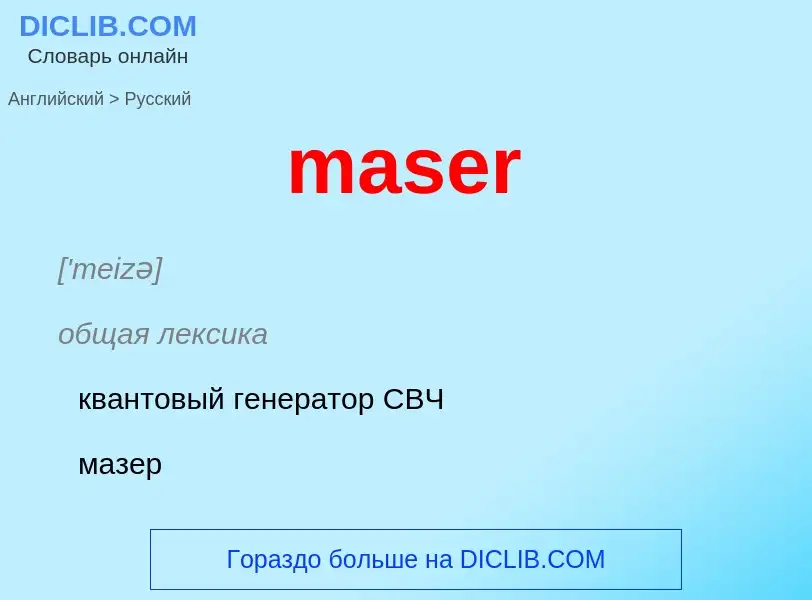Tradução e análise de palavras por inteligência artificial ChatGPT
Nesta página você pode obter uma análise detalhada de uma palavra ou frase, produzida usando a melhor tecnologia de inteligência artificial até o momento:
- como a palavra é usada
- frequência de uso
- é usado com mais frequência na fala oral ou escrita
- opções de tradução de palavras
- exemplos de uso (várias frases com tradução)
- etimologia
MASER - tradução para russo
['meizə]
общая лексика
квантовый генератор СВЧ
мазер
мазерный
физика
генератор квантовый молекулярный
существительное
физика
мазер
микроволновый квантовый генератор
существительное
общая лексика
мазер, квантовый усилитель
синоним
['reizə]
физика
разер
лазер радиодиапазона (на излучении)
существительное
физика
разер
лазер (на излучении) радиодиапазона
Definição
Wikipédia

A maser (, an acronym for microwave amplification by stimulated emission of radiation) is a device that produces coherent electromagnetic waves through amplification by stimulated emission. The first maser was built by Charles H. Townes, James P. Gordon, and Herbert J. Zeiger at Columbia University in 1953. Townes, Nikolay Basov and Alexander Prokhorov were awarded the 1964 Nobel Prize in Physics for theoretical work leading to the maser. Masers are also used as the timekeeping device in atomic clocks, and as extremely low-noise microwave amplifiers in radio telescopes and deep-space spacecraft communication ground stations.
Modern masers can be designed to generate electromagnetic waves at not only microwave frequencies but also radio and infrared frequencies. For this reason, Townes suggested replacing microwave with the word molecular as the first word in the acronym maser.
The laser works by the same principle as the maser but produces higher frequency coherent radiation at visible wavelengths. The maser was the forerunner of the laser, inspiring theoretical work by Townes and Arthur Leonard Schawlow that led to the invention of the laser in 1960 by Theodore Maiman. When the coherent optical oscillator was first imagined in 1957, it was originally called the "optical maser". This was ultimately changed to laser for "Light Amplification by Stimulated Emission of Radiation". Gordon Gould is credited with creating this acronym in 1957.

![quadrupole]] state selector, and the resonant cavity is at right. The 24 GHz microwaves exit through the vertical [[waveguide]] Townes is adjusting. At bottom are the vacuum pumps. quadrupole]] state selector, and the resonant cavity is at right. The 24 GHz microwaves exit through the vertical [[waveguide]] Townes is adjusting. At bottom are the vacuum pumps.](https://commons.wikimedia.org/wiki/Special:FilePath/Charles Townes and first maser.jpg?width=200)
![hydrogen maser]] (see description below) hydrogen maser]] (see description below)](https://commons.wikimedia.org/wiki/Special:FilePath/Hydrogen maser.gif?width=200)
